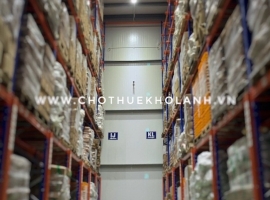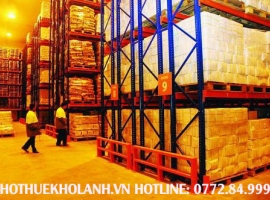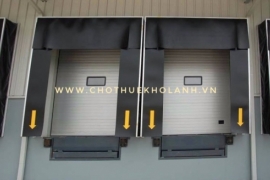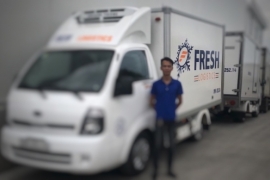HOW TO STORE FROZEN FOOD APPROPRIATELY? - USEFUL TIPS FOR BUSINESSES
How to store frozen food perfectly before reaching consumers is a problem that many businesss are facing today. With many years of experience in the frozen food industry, Nam Ha Noi Cold Storage will share our secrets with your business to preserve and store frozen goods in the best way.
I. Frozen food market and great potentials for businesses
a) The current frozen food market
According to market research and report by Allied Market Research (ARM):
Frozen food market size is being valued at $288.8 billion in 2019, estimated to reach $404.8 billion by 2027 at a Compound annual growth rate - CAGR is expected to be 4.2% from 2020 to 2027.
Ready meals segment is the largest turnover-generating product to date, followed by frozen meat and poultry products.
The frozen potato segment is expected to grow at the fastest CAGR of 4.8% from 2019 to 2027.
The frozen seafood products segment is expected to witness a CAGR of 4.4% during the same period.
If the above data is not enough for businesses to know the potential of the current market, let's analyze the real benefits of frozen food with the following content below.
b) What advantages does frozen food bring to the business?
The popularity of frozen foods in the food industry is increasing because they bring many great advantages to businesses:
Frozen foods can be stored for long-term use, preventing shortages in the market as well as making profits from price differences (for out-of-season products) to help businesses save more operating cost.
It takes less time to create dishes (for restaurants, fast food chains), reduces waiting time, and increases the end-consumers’ satisfaction and return.

The change of the main labor force (the percentage of female workers is increasing, accounting for 48.5% of the total number of employees in Vietnam) increases the use of frozen food → Profit from trading frozen food of the enterprise is also increased.
In addition, the increase of fast food chains such as KFC, McDonald's, Pizza Hut, Subway and Frozen Potatoes globally is an essential factor leading to the explosion of frozen food in many countries, including Vietnam.
Besides, the popularity of the Internet and smartphones in daily life increases the demand for purchases through online sales channels. Many businesses are gradually turning to online channels to increase product orders, and frozen products are one of the items that are in "huge" demand today.
In fact, frozen food businesses have many opportunities to develop to a new height. However, there are still many backlog issues that businesses need to solve to "pave the way" for the development of your business. What are those problems? Let's take a look at the next part of the article.
II. What is obstructing the development of the frozen food businesses?
i. What problem is your business facing?
You - frozen food manufacturers/distributors/retailers have been facing many challenges and difficulties to survive in the food industry.
Among them, the most pressing issue that your business has to face is how to bring products to the market in the fastest, safest and most intact way when reaching consumers.

Products must be perfectly preserved until they are distributed and sold to consumers
Different from other products, frozen food is a perishable item. It is very quickly changing its inherent properties if not stored properly. Any mistake in the process of preservation, storage, and transportation can cause frozen food to be lost, something that no food business wants.
Despite the expectations of businesses, frozen food is still lost and that number is not small at all:
Vietnam annually loses 694,000 tons of meat, 7 million tons of vegetables, 805,000 tons of seafood during storage and transportation.
Fruits and vegetables account for the largest share of wasted food products at 31%. Of which 26% came from damage due to improper preservation, much higher than the Southeast Asian average of 15%.
The above data, given at the World Cold Chain Summit in March 2018 in Ho Chi Minh City, shows that the loss of frozen food is still a persistent problem that many businesses haven’t resolved yet.
When a solution for storing, preserving and transporting frozen food is not found properly, business will still have to face losses - which is obstructing the development in a very "hot" market like today.
ii. Modern and economical storage solution for businesses
To have an appropriate method, many businesses have spent a lot of time, effort and money to find the best ways to solve the problem of storage, preservation and transportation. In which, 3 solutions are proposed including:
• Cold rooms:
The cold room is the result of the idea of replacing a freezer that does not have enough space to store food with a room maintained by a refrigeration system, taking up less space but saving. Cold rooms are applied by chain businesses such as grocery stores/restaurants/fast food stores to preserve and keep goods in the branch for longer.

• Private cold storages
Private cold storages are installed by the enterprises or hired construction service. Their capacity depends on the financial capacity and the amount of goods the company wants to preserve.
Private cold storages help businesses better store, preserve and control frozen goods. However, the amount of money spent to build a cold storage is very large, so usually only companies with strong finance and goods can invest.
• Industrial cold storage rental service
Industrial cold storage is a large space with all necessary equipment for frozen food preservation and is managed and operated by the Logistics company. It provides basic services that businesses need for comprehensive warehousing such as processing, packaging, preserving, storing and transporting frozen goods...
iii. What are the benefits of renting industrial cold storage for businesses?
When using the cold storage rental service, businesses do not need to use too much effort, time and human resources but can still store their products perfectly. Industrial cold storages even significantly reduce the loss and damage of goods for businesses, something many companies are expecting.
For businesses to better understand the benefits that industrial cold storage services bring, read the article: Cold storage rental service – an economical storage solution for businesses
Next, let’s come with useful frozen food storage tips for businesses in part III.
III. For businesses: The current best way to store frozen food!
With a wealth of experience (more than 20 years) in the Logistics industry and proud to be a large and reputable cold storage rental service provider in Hanoi, Nam Ha Noi cold storage will share with you the best way to store frozen food that we have used for many years.
Some concepts of food refrigeration
Preserving food for a long time with nearly intact quality is always a challenge, especially in a tropical climate like in our country. The best method of quality assurance is refrigeration. Depending on the type of food, we have different storage conditions.
Causes of food spoilage
Food is spoiled for three main reasons:
Due to the effect of yeast produced by the food itself
Due to the entry of microorganisms from outside
Due to toxins secreted from microorganisms
Among these causes, the impact caused by microorganisms is the greatest. Microorganisms exist mostly at -10oC to 80oC, so cooling to below -10oC will limit the growth of microorganisms.
Food after slaughtering and harvesting will have changes
Physically such as: change in color, shape, food shortage.
Chemical changes: chemical reactions that occur in food.
Physiological changes: Only with fruits and vegetables, the subjects that continue to respire after harvested.
Biochemical changes: After death, the temperature of animal cells increases. The heat of decomposition is greater than when the organism is alive, leading to the decomposition of the body. This phenomenon occurs strongly in aquatic products and seafood. Therefore, the faster the food is cooled, the slower the decomposition process and improve the preservation quality.
Methods of preserving different foods
1. Preservation of fresh fruits and vegetables

Vegetables and fruits continue to live after harvested. Normally, they reach about 50% to 75% biological maturity after harvested. During preservation process, fruits and vegetables continue to ripen.
During the growth process, vegetables and fruits accumulate bioenergy through photosynthesis in sunlight and receive minerals through the mother plant. After harvested, they continue to live and ripen thanks to the decomposition of bio-energy available in fruits and vegetables. Characteristic for this process is the intensity of respiration, O2 absorption and CO2 release.
In order to prolong the storage time and improve the quality of fruits and vegetables, it is necessary to limit the energy breakdown process, that is, to limit the respiratory process through 2 main ways:
Lower the temperature of the storage environment to reduce the reaction rate.
Change the atmosphere for fruit and vegetable preservation by increasing CO2 concentration and decreasing O2 concentration.
2. Preservation of meat
.jpg)
When it is necessary to preserve fresh meat for a short period of time from a few days to a few weeks, refrigeration method is used.
To preserve the optimal quality and prolong the shelf life of meat, meat should be cooled to near the freezing point temperature associated with the type of meat. The quality and shelf life of meat depends on the cooling rate and the packaging type. After slaughter and preliminary processing, the surface temperature of the meat should be lowered as quickly as possible. The shorter the time, the lower the loss of meat and keep the fresh color of the meat.
Meat that is properly prepared and stored at temperatures below -18°C can keep its quality for 12 months or longer.
3. Preservation of aquatic products and seafood
Aquatic products and seafood after being fished do not have a ripening stage or take place very short, only a few tens of minutes and quickly turns to the decomposition stage. So in general, if this product is not refrigerated or processed immediately after fishing, it will decompose within 3 to 10 hours.
The lower the temperature, the more inhibited the decay and invasion of microorganisms. For every further 10°C lower the temperature, the decay rate decreases by ½ to ⅓.
Some molds are still present at 10°C with 15% water on seafood so this product must be stored between −25 °C and −18 °C.

4. Some rules to note during the operation of the cold storage to keep the food good
Make sure the refrigeration machinery/equipment, grid power system, backup generator always work well. Maintain regular air-conditioner cleaning service contract with reputable companies to ensure the ability to overcome troubleshooting in a short time; at the same time always consider the backup plans in the worst case.
Clean room/cold storage regularly: Shelves/pallets should be shallow and well ventilated for quick and easy cleaning. Follow a fixed schedule to ensure that the room/warehouse is cleaned on a consistent basis. Follow the FIFO system for frozen foods. (FIFO stands for First In, First Out) Accordingly, inventory items will be sorted first, in order from oldest to newest.
Designate pallet areas for certain items and arrange items only in the correct places. Never leave a warehouse door open for longer than necessary.

Perhap the lack of time and personnel will make it difficult to comply with the above rules. However, the business can keep the way to preserve frozen food to avoid loss if it can be done! Hopefully, your business can soon apply and succeed with the above methods. Nam Ha Noi cold storage will always companion with businesses/restaurants/chain stores in storing and preserving frozen foods. If you are looking for a cold storage rental service in Hanoi or surrounding areas, please quickly call: 0772.844.999 for advice in the fastest time.

Nam Ha Noi cold storage - a reliable partner in the preservation, storage and transportation of frozen goods








